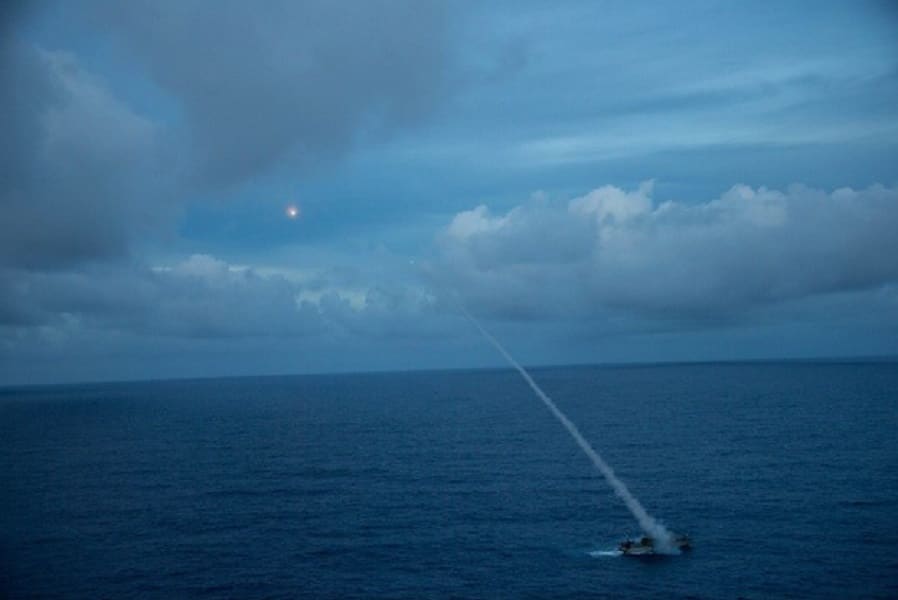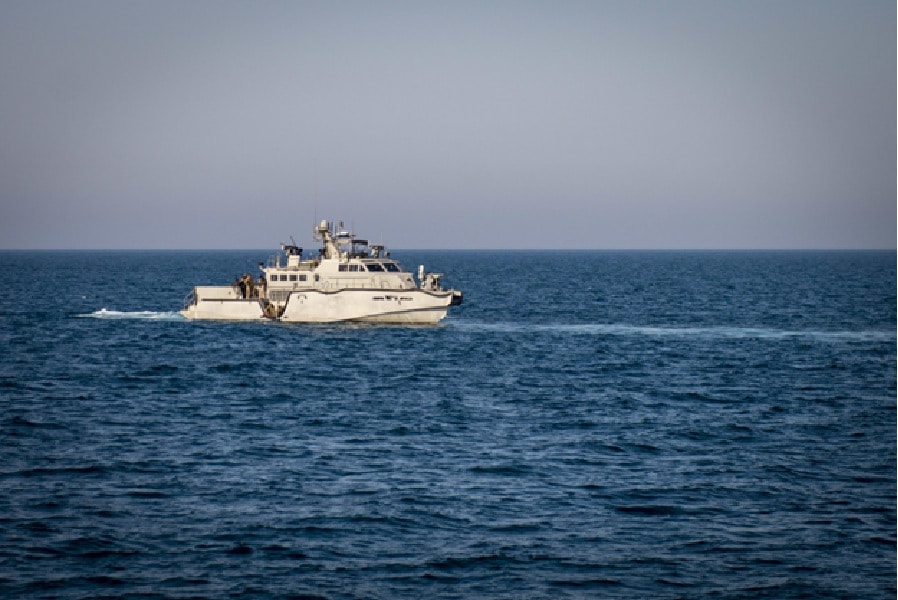Zarvan
ELITE MEMBER

- Joined
- Apr 28, 2011
- Messages
- 54,470
- Reaction score
- 87
- Country
- Location

The Mark VI Patrol Boat, armed with a MK 38 MOD 2 25mm autocannon forward and aft, can also carry a RHIB at the stern. Mk VIs also have remote .50cal heavy machine guns and mounts for six additional crew-served weapons. This aluminum craft is lightly armored with a crew of ten and can transport eight passengers. Range is 600+ nautical miles. US Navy photo.
U.S. Navy Advises On The Fate Of The Mark VI Patrol Boats
The fate of the twelve U.S. Navy Mark VI Patrol Boats has led to U.S. Navy, Media, and public speculation as to their usefulness in peer nation conflicts. Armed with one or two 25mm MK 38 autocannons and various .50cal heavy machine guns and 40mm automatic grenade launchers, the waterjet-powered MK VIs have been instrumental in littoral patrols, screenings, shipboard inspections, deterrence, and large ship escorts. Their usefulness comes into question when out in the open ocean and against larger adversary warships equipped with guided missiles, capable sensors, and electronic countermeasures.
Peter Ong 19 Aug 2021
Naval News asked the U.S. Navy’s Chief of Information Department (CHINFO) on August 2021 for an update on the possible early divestment, decommission, and the fate of the twelve Mark VI Patrol Boats (PB) that are serving the U.S. Navy with distinction. While the U.S. Navy is contemplating the MK VIs’ divestment, Ukraine on the other hand, has an interest in acquiring up to sixteen Mark VIs with upgraded weapons and equipment for their own navy.

As the U.S. Navy shifts towards peer nation challenges, the Mark VIs are not seen as a required player for open ocean deterrence or for combat. At the Surface Navy Association 2021, Major General Tracy King, USMC, Director, Expeditionary Warfare (N95) did state that the twelve MK VIs “Were very expensive to maintain.” (The MK VI uses two diesel engines to power waterjets instead of shafts and propellers). Major General King also mentioned that in wargaming scenarios against peer nations, the MK VIs were deemed not really needed (given their small size and limited missile firepower). Repeated inquiries by Naval News to the U.S. Navy asking why the Mark VIs are slated for early retirement (questions related to possible issues regarding their mechanical and engineering, design flaws, upkeep, extensive maintenance, poor reliability, or degrading role and purpose) have not been answered or confirmed.
If the U.S. Navy does decide to prematurely retire the twelve Mark VI Patrol Boats, the U.S. Navy does have a preliminary fate for them. Lt. Lewis Aldridge, a U.S. Navy spokesperson said:
Thus, the 12 PBs will not be scuttled or scrapped (the U.S. Navy originally planned to acquire 48 Mark VI Patrol Boats).“The MK VIs will be returned to the Boat Inventory Manager in the continental U.S. for final disposition. The Navy continues to assess options for final disposition, including the potential transition to another service or another U.S. government agency, nomination for Foreign Military Sales, or placement into long-term storage.”
Naval News comments

U.S. Marines with 2nd Low Altitude Air Defense Battalion, 31st Marine Expeditionary Unit (MEU), fire a FIM-92 Stinger missile from a U.S. Navy Mark VI patrol boat with Maritime Expeditionary Security Squadron TWO for the first time ever during a live fire exercise in the Philippine Sea, Feb. 27, 2021. The exercise was conducted to test the effectiveness of firing various weapon systems at sea from smaller, more expeditionary platforms than are traditionally used. The 31st MEU is operating aboard ships of the Amphibious Squadron 11 in the 7th fleet area of operations to enhance interoperability with allies and partners and serve as a ready response force to defend peace and stability in the Indo-Pacific region. U.S. Marine Corps photo by 1st Lt. Stephanie Murphy.
For purely speculative analytical purposes, the live-fire exercise photos in this story appear to contradict what USMC Major General Tracy King stated at SNA 2021 about the Mark VIs not having a role and purpose in a conflict with peer nations and with USMC General David H. Berger’s Force Design 2030’s philosophies. While far from the size of fleet warships, the twelve small MK VIs might be able to hide better in radar and sea clutter so as not to present such a large threatening target, and through Distributed Maritime Operations and Distributed Lethality, the MK VIs could prove to be a “Mosquito Fleet” for the U.S. Navy through the incorporation of guided missiles such as Stinger Short-range Air Defense Systems (SHORADS), Javelin Anti-Tank Guided Missiles (ATGMs). SPIKE Non-Line-of-Sight (NLOS) ATGMs, 2.75-inch APKWS laser-guided rockets, and/or JQL/JAGM quad-cell launchers. Those guided rockets and missiles have a range of three to seventeen miles (4.8 to 25 kilometers). Furthermore, the MK VIs can be modified to carry miniature or micro-torpedoes for added sting.

While the U.S. Navy would not confirm on if the MK VI PBs have any critical “Showstopping issues” that affect their missions, Readiness, deployments, or duties, the U.S. Navy did state that it doesn’t intend to replace the Cyclone-class Patrol Coastals (PC) or invest in a future small Patrol Boat replacement platform, preferring to field the much larger Littoral Combat Ship (LCS) and also use small U.S. Coast Guard boats for the soon-to-be-deactivated U.S. Navy PC and PB roles. Naval News provided analysis on this approach.
The concept of using many small patrol boats as a “Mosquito Fleet” for the U.S. Marines does have merit as the U.S. Navy stated that it has lost a wargame against China here and here because the concentration of large U.S. Navy warships forming Carrier Strike Groups and Amphibious Ready Groups invited adversary anti-ship ballistic and cruise missiles into a tight “Kill Zone” whereas much smaller boats spread vastly apart may not attract as much attention from enemy anti-ship missiles.

CTF 56 is responsible for planning and execution of expeditionary missions, in the U.S. 5th Fleet area of operations and is deployed in support of naval operations to ensure maritime stability and security in the Central Region, connecting the Mediterranean Sea and Pacific Ocean through the Western Indian Ocean and three strategic chokepoints to the free flow of global commerce. U.S. Navy photo by Mass Communication Specialist 2nd Class William Collins III
This does raise the question on if Unmanned Surface Vessels (USVs) such as the MARTAC’s Devil Ray and the Saildrone can be used instead of small manned patrol boats to constitute any “Mosquito Fleet” and thus enhance Force Design 2030 and the U.S. Navy’s distributed operations beliefs. Nonetheless, this photo below shows the value of having small manned patrol boats that can launch USVs and Unmanned Underwater Vessels (UUVs) that require a crew of sailors to launch and retrieve, making the small patrol boat a mini-LCS in its own right, respectively.
Having inexpensive small boats perform missions that affect the battlespace, multitask, and carry customizable “undisclosed payloads” does spike interest with adversaries and peer nations in the U.S Navy’s tactical unpredictability as described in this article by USNI regarding the LCS’s Mission Modules and Payload Bay’s cargo attracting more attention and monitoring from a peer nation’s navy than from a regular AEGIS Arleigh Burke-class destroyer transiting the same area.
The United States possesses a robust industry in designing and constructing (new) small patrol boats along with USVs and UUVs of all shapes and sizes if the U.S. Navy decides to replace the MK VIs with a vessel of similar size. How the U.S. Navy and the U.S. Marine Corps intends to employ a distributed strategy, and with what types or new vessels and resources, remains to be seen, but don’t dismiss the future of having the small patrol boat from the U.S. Navy’s and U.S. Marine Corp’s boat inventories just yet.
TAGS Mark VI Patrol Boat U.S. Navy
Facebook Twitter Stumble linkedin PinterestMore
AUTHORS
Posted by : Peter Ong
Peter Ong is a Freelance Writer with United States and International Federation of Journalists (IFJ) media credentials and lives in California. Peter has a Bachelor's Degree in Technical Writing/Graphic Design and a Master's Degree in Business. He writes articles for defense, maritime and emergency vehicle publications.
U.S. Navy Advises On The Fate Of The Mark VI Patrol Boats - Naval News
